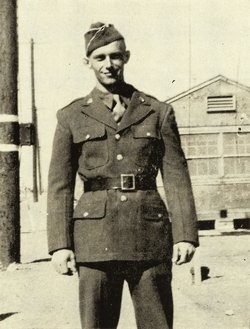Newmanstown Soldier Killed in France
Pfc. Emerson M. Bair, twenty. five, of Newmanstown, is reported killed in action in France, July 12. according to a telegram received by his wife. Mrs. Betty Bair, from the office of the Adjutant General in Washington.
Pfc. Bair entered the service in Dec. 1942 and received his basic training at Camp Barkley, Texas. Later he was stationed at Camp Granite, Calif. and Fort Dix, N.J. He was serving with the Infantry, and was overseas since March 1944. Pfc. Bair was in the Normandy invasion from the beginning.
He was the son of Mr. and Mrs. Chester A. Bair, Newmanstown, and was associated with his father in the tombstone business, He was member of Elias Lutheran church and a graduate of Millereek High School, class of '37.
Besides his parents and wife, he Is survived by the following: a sis-Dorothy Bair, and a brother, Chester Bair. both of Newmansown.
Memorial services will be conducted in the Elias Lutheran church on Sunday by the pastor, Rev. Q. N. Schaeffer.
Lancaster New Era (Lancaster, Pennsylvania) Saturday, August 12, 1944
Pfc. Bair entered the service in Dec. 1942 and received his basic training at Camp Barkley, Texas. Later he was stationed at Camp Granite, Calif. and Fort Dix, N.J. He was serving with the Infantry, and was overseas since March 1944. Pfc. Bair was in the Normandy invasion from the beginning.
He was the son of Mr. and Mrs. Chester A. Bair, Newmanstown, and was associated with his father in the tombstone business, He was member of Elias Lutheran church and a graduate of Millereek High School, class of '37.
Besides his parents and wife, he Is survived by the following: a sis-Dorothy Bair, and a brother, Chester Bair. both of Newmansown.
Memorial services will be conducted in the Elias Lutheran church on Sunday by the pastor, Rev. Q. N. Schaeffer.
Lancaster New Era (Lancaster, Pennsylvania) Saturday, August 12, 1944


 Lizzie Kunde
Lizzie Kunde 

